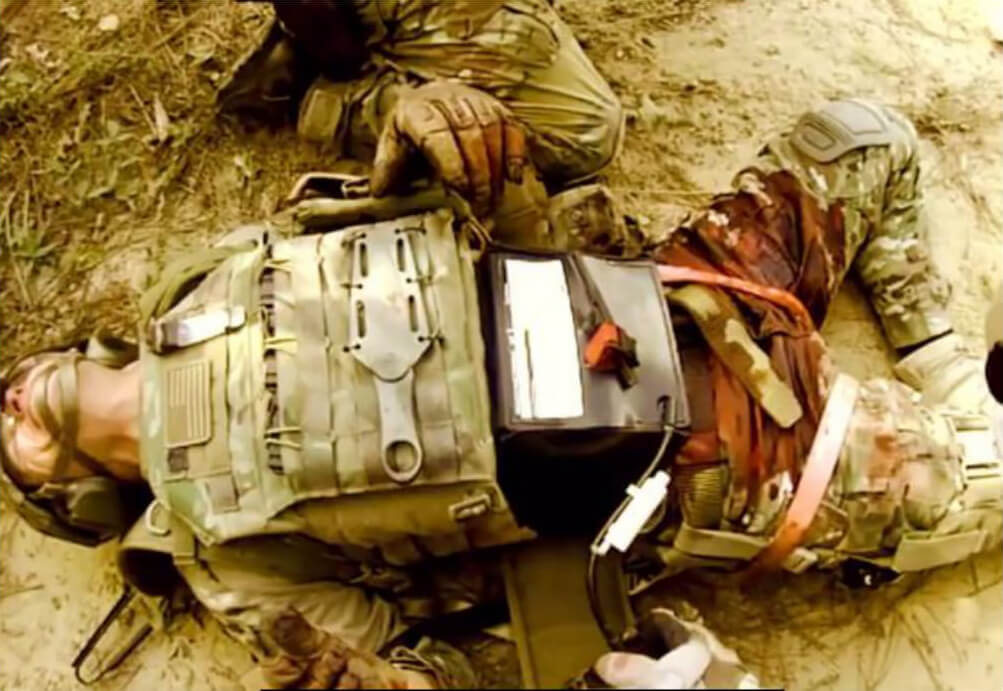Noncompressible torso hemorrhage is recognized as the leading cause of death in trauma, but definitive hemorrhage control has been challenging.
 Limb exsanguination is no longer the most common cause of preventable death on the battlefield because of emergency tourniquets. Hemorrhage control for wounds in the junction between the trunk and the limbs and in the neck are an obvious care gap, most commonly in the pelvic area, including the buttocks and groin proximal to the inguinal ligament. (US Army Med Dep J 2011 Apr-Jun:38.) Managing hemorrhagic shock also requires support of central aortic pressure to maximize perfusion of the brain and heart and to control bleeding effectively.
Limb exsanguination is no longer the most common cause of preventable death on the battlefield because of emergency tourniquets. Hemorrhage control for wounds in the junction between the trunk and the limbs and in the neck are an obvious care gap, most commonly in the pelvic area, including the buttocks and groin proximal to the inguinal ligament. (US Army Med Dep J 2011 Apr-Jun:38.) Managing hemorrhagic shock also requires support of central aortic pressure to maximize perfusion of the brain and heart and to control bleeding effectively.
Noncompressible torso hemorrhage is recognized as the leading cause of death in trauma, but definitive hemorrhage control has been challenging. A review of combat casualties from 2001 to 2011 showed that the most common sites of lethal hemorrhage were truncal (67.3%), junctional (19.2%), and peripheralextremity (13.5%). (J Trauma Acute Care Surg 2012;73[6 Suppl 5]:S431.)
The direct application of pressure over the distal aorta with an abdominal tourniquet and the insertion of a resuscitative endovascular balloon to occlude the aorta (REBOA) has recently come to the forefront as a potential life-saving option. The problem is bleeding from noncompressible vascular injuries. Traumatic or iatrogenic injuries to the common iliac, external iliac, internal iliac, profunda femoral, and superficial femoral can cause bleeding that is extremely difficult to control. (J Cardiovasc Surg (Torino) 2012;53[4]:495.) Exsanguination from one of these vessels can occur in minutes or even seconds.
Pulsed-wave Doppler measurements have documented that blood flow to the common femoral arterycan be stopped by applying direct pressure over the distal abdominal aorta or proximal iliac artery. (Prehosp Disaster Med 2006;21[6]:379.) A number of reports have now documented the ability to stop blood flow to these major vessels with the Abdominal Aortic and Junctional Tourniquet-Stabilized (AAJT-S) and the
REBOA. (Mil Med 2013;178[11]:1196; J Trauma Acute Care Surg 2013;75[1]:122; J Trauma Acute Care Surg 2013;75[3]:506.) Major trauma center experience with REBOA suggests that it is feasible and effective for proactive aortic control in patients with end-stage shock from blunt and penetrating mechanisms. (J Spec Oper Med 2013;13[3]:1.) Likewise, real-life experience with the AAJT-S also suggests that it can save lives. (J Spec Oper Med 2013;13[2]:1; Surgery 2011;150[3]:400.)
The AAJT-S and REBOA are relatively new concepts in emergency medicine, and their potential benefits and roles in managing life-threatening bleeding remain untapped to a significant degree. A respectable amount of research has been done for these tools and the FDA has approved several different applications of the AAJT-S, so it’s time to get broader clinical and research experience with them.
The AAJT-S has other applications besides inguinal and groin hemorrhage. The FDA approved it for life-threatening axillary hemorrhage, and it has been used off-label for life-threatening neck hemorrhage.
But what about using the AAJT-S or REBOA instead of cross-clamping the aorta when an open thoracotomy is performed? One animal study specifically looked at the use of REBOA for that purpose. (Can Med Assoc J 1964;91:128.) The AAJT-S would obviously occlude the aorta lower than the thoracic diaphragm cross-clamping location typically used during open thoracotomy, but cross-clamping the aorta during an open thoracotomy has been fraught with difficulty and plagued by operator inexperience. Many an esophagus has been inadvertently cross-clamped, and the traumatic injury to the aorta and its branching vessels from dissection and cross-clamping can be significant. The lower-placed AAJT-S would not occlude blood flow to the kidneys and the superior mesenteric artery, but maybe it’s not a bad idea to preserve blood flow to the kidneys and mesentery in addition to the brain and heart.
The biggest drawbacks to the REBOA are the technical skills required for insertion and the actual time it takes to insert the balloon. I want something fast when my patient is hemorrhaging uncontrollably, and that is where the AAJT-S fills the bill: it can be applied in less than 60 seconds. It’s possible these two tools can be used together effectively, with the AAJT-S being applied immediately to allow additional time for REBOA placement.
REBOA for stopping uncontrolled bleeding in pelvic fractures has been reported as quite effective. Posted by Larry Mellick, MD at 4:24 PM Be the first to comment REBOA for stopping uncontrolled bleeding in pelvic fractures has been reported as quite effective. Again, it would be great to see some experience with the application of the AAJT-S for that sameindication. Researchers reported in 1964 that compression of the aorta with the heel of the hand just
above the bifurcation of the common iliac arteries was an effective way of controlling catastrophic pelvic hemorrhage during laparotomy. (Ann Emerg Med 2013 Oct 23; doi:
10.1016/j.annemergmed.2013.09.026.) More recent reports describe external manual compression for abdominal bleeding associated with penetrating injuries and ruptured abdominal aortic aneurysms. (J Anesth 2002;16[2]:164; Obstet Gynecol 2014;123[4]:804.) Pelvic binding and the AAJ-ST might slow blood loss significantly in pelvic fractures.
Postpartum hemorrhage is another life-threatening emergency that can occur after a Caesarean section or vaginal delivery. It is one of the most common obstetric maternal complications, and is responsible for approximately half of severe maternal morbidity. (Transfusion 2014 Mar 12; doi: 10.1111/trf.12550.) Worldwide, postpartum hemorrhage is a common etiology of maternal death, and uterine atony is the major associated cause. (WHO Guidelines; http://bit.ly/1nECNO7.) External manual compression of the aorta is a common treatment for life-threatening post-partum hemorrhage. (Anaesth Intensive Care 1994;22[5]:571.) A commonly referenced case report describing successful management of a hemorrhaging patient with this technique was published in 1994. (Circulation 1993;88[4 Pt 1]:1916.) Again, here is another condition where it seems the AAJT-S could play a life-saving role in slowing uterine bleeding while other interventions are being started.
Applying the abdominal tourniquet during CPR has been discussed as one way to shunt blood flow selectively to the heart and brain, meeting CPR’s goal of maintaining blood flow to the vital organs until the heart can once again function independently. Aortic compression to augment cardiopulmonary resuscitation has been written about for decades. The results were variable, though, and a number of well-done papers demonstrated improved resuscitation parameters and outcomes when the aorta was occluded during CPR. (Am J Emerg Med 2002;20[5]:453; Resuscitation 2001;50[3]:319; Resuscitation 1999;40[3]:171; Resuscitation 2011;82[8]:1087; Resuscitation 2007;75[3]:515; Crit Care Med 1997;25[6]:1003.)
Applying the AAJT-S during CPR is a study that simply must be done. A significant step forward will have occurred in advanced cardiac life support if a distinctly positive outcome similar to the animal studies is found.
Both these tools can save lives for a wide spectrum of different life-threatening conditions. Unfortunately, the AAJT-S and the REBOA are currently relatively unknown and not being used. Emergency medicine and trauma programs need to include training in how to apply the AAJT-S and how to insert the REBOA. And, of course, we need increased research and assessment of various clinical applications.

